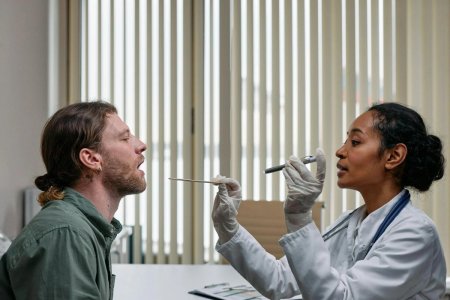Invasive infection on the rise: What the latest CDC report reveals
By
Veronica E.
- Replies 0
Infections are something most of us have dealt with at some point in our lives—but when common bacteria start behaving in uncommon ways, it’s worth paying attention.
A recent report from the Centers for Disease Control and Prevention (CDC) reveals a concerning rise in a severe form of strep infection that’s catching many by surprise.
For older adults and those managing chronic health conditions, understanding this trend could be more important than ever.
Invasive group A streptococcus (or iGAS) isn’t just your average sore throat.
While group A strep is known for causing strep throat and minor skin infections, invasive cases occur when the bacteria spread to parts of the body like the bloodstream, muscles, or lungs.
This can lead to life-threatening illnesses such as necrotizing fasciitis—often referred to as “flesh-eating disease”—or toxic shock syndrome.

Dr. Victor Nizet, a pediatric specialist at the University of California, San Diego, describes how quickly these infections can progress—sometimes turning from mild symptoms to a medical emergency within hours.
The CDC’s findings, which cover about 35 million Americans across 10 states, show infection rates doubling from 4 to 8 out of every 100,000 people between 2013 and 2022.
That means reported cases jumped from 1,082 in 2013 to 2,759 in 2022.
Before then, invasive strep infection rates had remained steady for 17 years.
Over a nine-year period, more than 21,000 cases of invasive strep were recorded, resulting in nearly 2,000 deaths.
When projected nationally, experts estimate the real toll may exceed 10,000 lives.
The study highlights several contributing factors, including rising rates of chronic conditions like diabetes and obesity—both of which can weaken the body’s ability to fight infection.
The data also reveals that people who inject drugs and individuals experiencing homelessness are especially at risk.
In fact, among the homeless population, the infection rate reached 807 out of 100,000 in 2022—one of the highest ever recorded globally.
Another challenge: some strains of group A strep are becoming less responsive to certain antibiotics, making treatment more complex.
While the biggest increase has been seen in adults, there’s also concern around severe pediatric cases, such as those involving necrotizing fasciitis, according to Dr. Allison Eckard, a pediatric infectious disease expert from the Medical University of South Carolina.
The CDC is urging greater awareness and action to help prevent the spread of invasive strep.
For many, this means being proactive: practicing good hygiene, watching for signs of infection, and seeking medical care early.
Healthcare professionals are also pushing for the development of a vaccine, especially as antibiotic resistance continues to grow.
However, progress toward that goal faces challenges, including shifting priorities among regulatory bodies.
Here are a few steps you can take to stay safe:
While the rise in invasive strep infections is concerning, staying informed and proactive can make all the difference.
By looking out for one another and taking simple preventive steps, we can help keep our community safe and healthy.
Read next: What was meant to protect her, only led to more danger: How did this woman contract the "world's deadliest" virus?

We’d love to hear from you. Have you or someone close to you been affected by a serious strep infection? What are you doing to stay healthy and informed? Share your thoughts in the comments!
A recent report from the Centers for Disease Control and Prevention (CDC) reveals a concerning rise in a severe form of strep infection that’s catching many by surprise.
For older adults and those managing chronic health conditions, understanding this trend could be more important than ever.
Invasive group A streptococcus (or iGAS) isn’t just your average sore throat.
While group A strep is known for causing strep throat and minor skin infections, invasive cases occur when the bacteria spread to parts of the body like the bloodstream, muscles, or lungs.
This can lead to life-threatening illnesses such as necrotizing fasciitis—often referred to as “flesh-eating disease”—or toxic shock syndrome.

Invasive strep infections are on the rise, with health experts urging older adults to stay informed and take preventive steps. Image Source: Pexels / cottonbro studio.
Dr. Victor Nizet, a pediatric specialist at the University of California, San Diego, describes how quickly these infections can progress—sometimes turning from mild symptoms to a medical emergency within hours.
The CDC’s findings, which cover about 35 million Americans across 10 states, show infection rates doubling from 4 to 8 out of every 100,000 people between 2013 and 2022.
That means reported cases jumped from 1,082 in 2013 to 2,759 in 2022.
Before then, invasive strep infection rates had remained steady for 17 years.
The human cost and contributing factors
Over a nine-year period, more than 21,000 cases of invasive strep were recorded, resulting in nearly 2,000 deaths.
When projected nationally, experts estimate the real toll may exceed 10,000 lives.
The study highlights several contributing factors, including rising rates of chronic conditions like diabetes and obesity—both of which can weaken the body’s ability to fight infection.
The data also reveals that people who inject drugs and individuals experiencing homelessness are especially at risk.
In fact, among the homeless population, the infection rate reached 807 out of 100,000 in 2022—one of the highest ever recorded globally.
Another challenge: some strains of group A strep are becoming less responsive to certain antibiotics, making treatment more complex.
While the biggest increase has been seen in adults, there’s also concern around severe pediatric cases, such as those involving necrotizing fasciitis, according to Dr. Allison Eckard, a pediatric infectious disease expert from the Medical University of South Carolina.
Also read: See the horrifying footage: This cooking mistake could lead to a dangerous parasite infection!
Why vigilance—and possibly a vaccine—matters
The CDC is urging greater awareness and action to help prevent the spread of invasive strep.
For many, this means being proactive: practicing good hygiene, watching for signs of infection, and seeking medical care early.
Healthcare professionals are also pushing for the development of a vaccine, especially as antibiotic resistance continues to grow.
However, progress toward that goal faces challenges, including shifting priorities among regulatory bodies.
Also read: Could a surprising infection double your chances of a heart attack? Find out!
What you can do
Here are a few steps you can take to stay safe:
- Stay informed – Follow updates from trusted health organizations like the CDC.
- Practice good hygiene – Handwashing and proper wound care go a long way.
- Keep an eye on symptoms – If something feels off, especially if you have existing conditions, don’t wait to call your doctor.
- Talk to your healthcare provider – Ask about ways to reduce your risk and stay protected.
While the rise in invasive strep infections is concerning, staying informed and proactive can make all the difference.
By looking out for one another and taking simple preventive steps, we can help keep our community safe and healthy.
Read next: What was meant to protect her, only led to more danger: How did this woman contract the "world's deadliest" virus?
Key Takeaways
- The number of invasive group A strep infections in the US has more than doubled from 2013 to 2022, following 17 years of stability.
- The infection can lead to severe conditions like necrotizing fasciitis, also known as flesh-eating disease, and streptococcal toxic shock syndrome.
- Contributing factors to the rise may include increased rates of diabetes, obesity, drug injection, and homelessness, as well as the emergence of more diverse and possibly drug-resistant strains of group A streptococcus.
- Despite the higher infection rates observed in adults, especially those aged 65 and over, there has not been a detected increase in children, which contradicts clinical anecdotes from children’s hospitals reporting severe pediatric cases.
We’d love to hear from you. Have you or someone close to you been affected by a serious strep infection? What are you doing to stay healthy and informed? Share your thoughts in the comments!






